TOYOTA PRIUS 2017 4.G Quick Reference Guide
Manufacturer: TOYOTA, Model Year: 2017, Model line: PRIUS, Model: TOYOTA PRIUS 2017 4.GPages: 56, PDF Size: 4.12 MB
Page 21 of 56
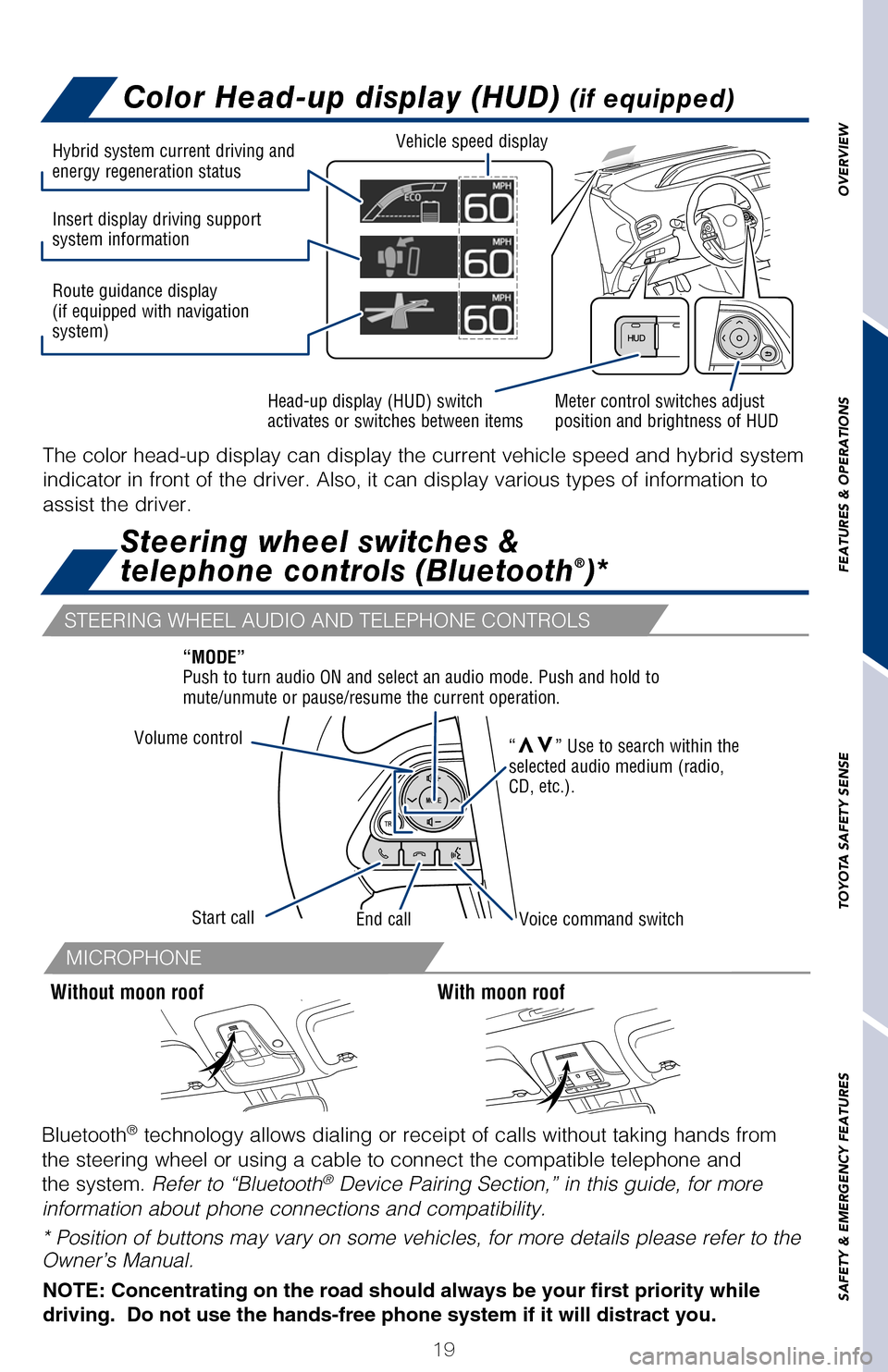
OVERVIEW
FEATURES & OPERATIONS
TOYOTA SAFETY SENSE
SAFETY & EMERGENCY FEATURES
MICROPHONE
STEERING WHEEL AUDIO AND TELEPHONE CONTROLS
19
Color Dual Multi-Information Display (MID)
Steering wheel switches &
telephone controls (Bluetooth®)*
Push “vv” to change between the following information screens, “” to select,
“vv” to switch contents and “” to go back:
The default split screen mode can also be viewed in simple screen mode s\
hown
above. The main display shows basic drive information. Push “
” to view more
info for mileage and average fuel consumption display.
For more details, see Owner’s Manual.
For more details, see Owner’s Manual.
Warning message display
Settings display
Driving assist system information
(if equipped) Navigation system-linked
display (if equipped)
Audio system-linked
display (if equipped)
Air conditioning system
settings screen
Without moon roofWith moon roof
Bluetooth
® technology allows dialing or receipt of calls without taking hands from\
the steering wheel or using a cable to connect the compatible telephone \
and
the system. Refer to “Bluetooth
® Device Pairing Section,” in this guide, for more
information about phone connections and compatibility.
* Position of buttons may vary on some vehicles, for more details please\
refer to the
Owner’s Manual.
Color Head-up display (HUD) (if equipped)
The color head-up display can display the current vehicle speed and hybr\
id system
indicator in front of the driver. Also, it can display various types of \
information to
assist the driver.
NOTE: Concentrating on the road should always be your first priority whi\
le
driving. Do not use the hands-free phone system if it will distract you\
.
Meter control switches adjust
position and brightness of HUD
Head-up display (HUD) switch
activates or switches between items Vehicle speed display
Hybrid system current driving and
energy regeneration status
Insert display driving support
system information
Route guidance display
(if equipped with navigation
system)Hybrid system indicator and
current fuel
Volume control
Start callEnd callVoice command switch
“MODE”
Push to turn audio ON and select an audio mode. Push and hold to
mute/unmute or pause/resume the current operation.
“
vv” Use to search within the
selected audio medium (radio,
CD, etc.).
2017_Prius_D6_1.indd 199/25/16 2:38 AM
Page 22 of 56
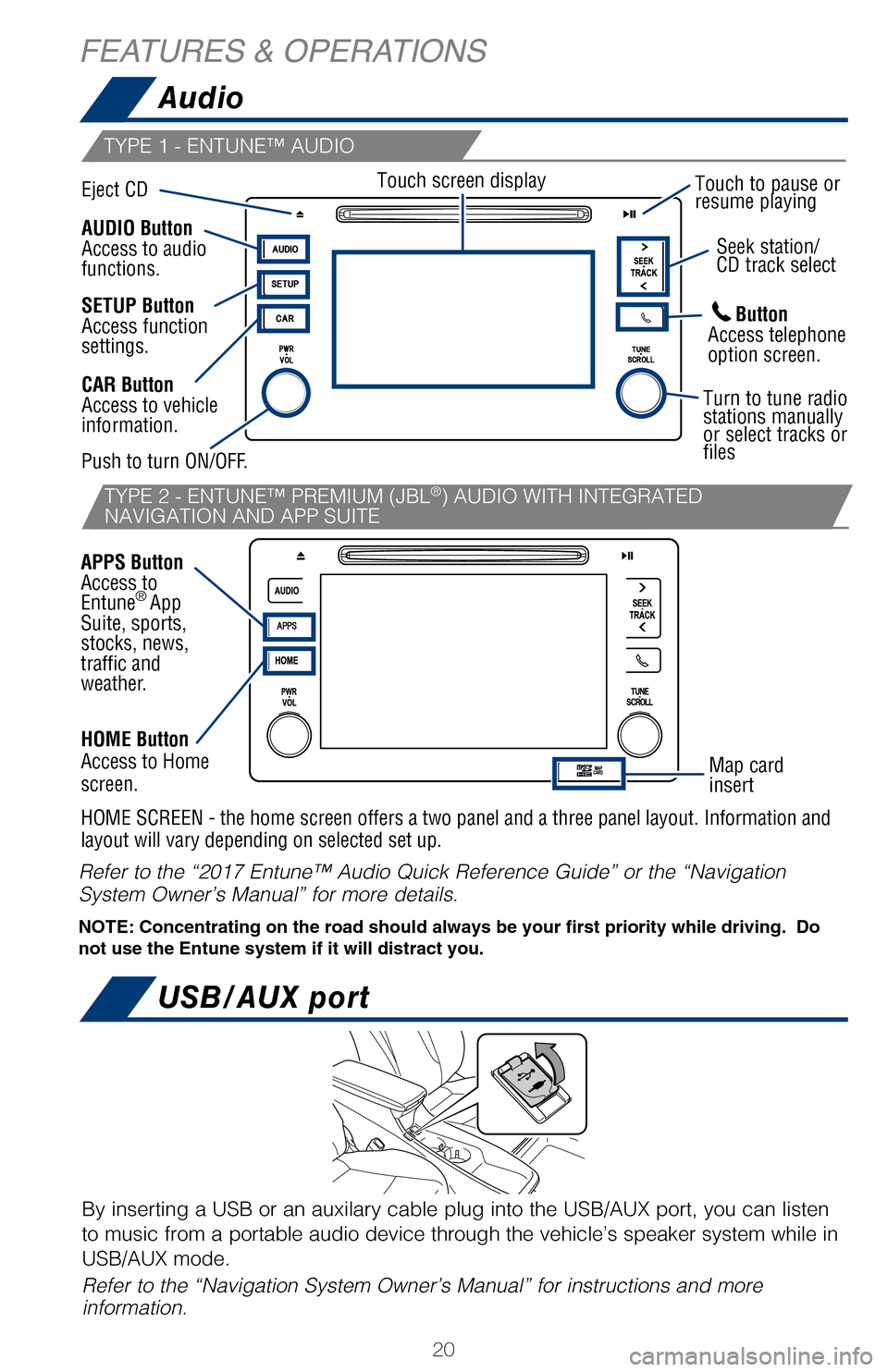
20
TYPE 1 - ENTUNE™ AUDIO
TYPE 2 - ENTUNE™ PREMIUM (JBL®) AUDIO WITH INTEGRATED
NAVIGATION AND APP SUITE
Audio
USB/AUX port
The power switch must be in ACCESSORY or ON mode.
A portable device can be charged by just placing Qi standard wireless cha\
rge
compatible portable devices according to the Wireless Power Consortium, such as
smart phones and mobile batteries, etc., on the charge area.
This function cannot be used with portable devices that are larger than the
charging area. Also, depending on the portable device, it may not operate
normally.
See Owner’s Manual for compatible portable devices.
HOME Button
Access to Home
screen.
HOME SCREEN - the home screen offers a two panel and a three panel layou\
t. Information and
layout will vary depending on selected set up.
FEATURES & OPERATIONS
Front
Power switch must be set at “ACCESSORY” or “ON” mode to be used.
Eject CD Seek station/
CD track select
Map card
insert
SETUP Button
Access function
settings.
Touch screen display
Turn to tune radio
stations manually
or select tracks or
files
Touch to pause or
resume playing
Refer to the “2017 Entune™ Audio Quick Reference Guide” or the “N\
avigation
System Owner’s Manual” for more details.
NOTE: Concentrating on the road should always be your first priority whi\
le driving. Do
not use the Entune system if it will distract you.
By inserting a USB or an auxilary cable plug into the USB/AUX port, you ca\
n listen
to music from a portable audio device through the vehicle’s speaker system while in
USB/AUX mode.
Refer to the “Navigation System Owner’s Manual” for instructions and\
more
information.
Push power supply charging button.
(1)
Charge area
Orange light - device is charging.
Green light - device is finished charging.
Push to turn ON/OFF.
Button
Access telephone
option screen.
AUDIO Button
Access to audio
functions.
CAR Button
Access to vehicle
information.
APPS Button
Access to
Entune
®
App
Suite, sports,
stocks, news,
traffic and
weather.
2017_Prius_D6_1.indd 209/25/16 2:38 AM
Page 23 of 56
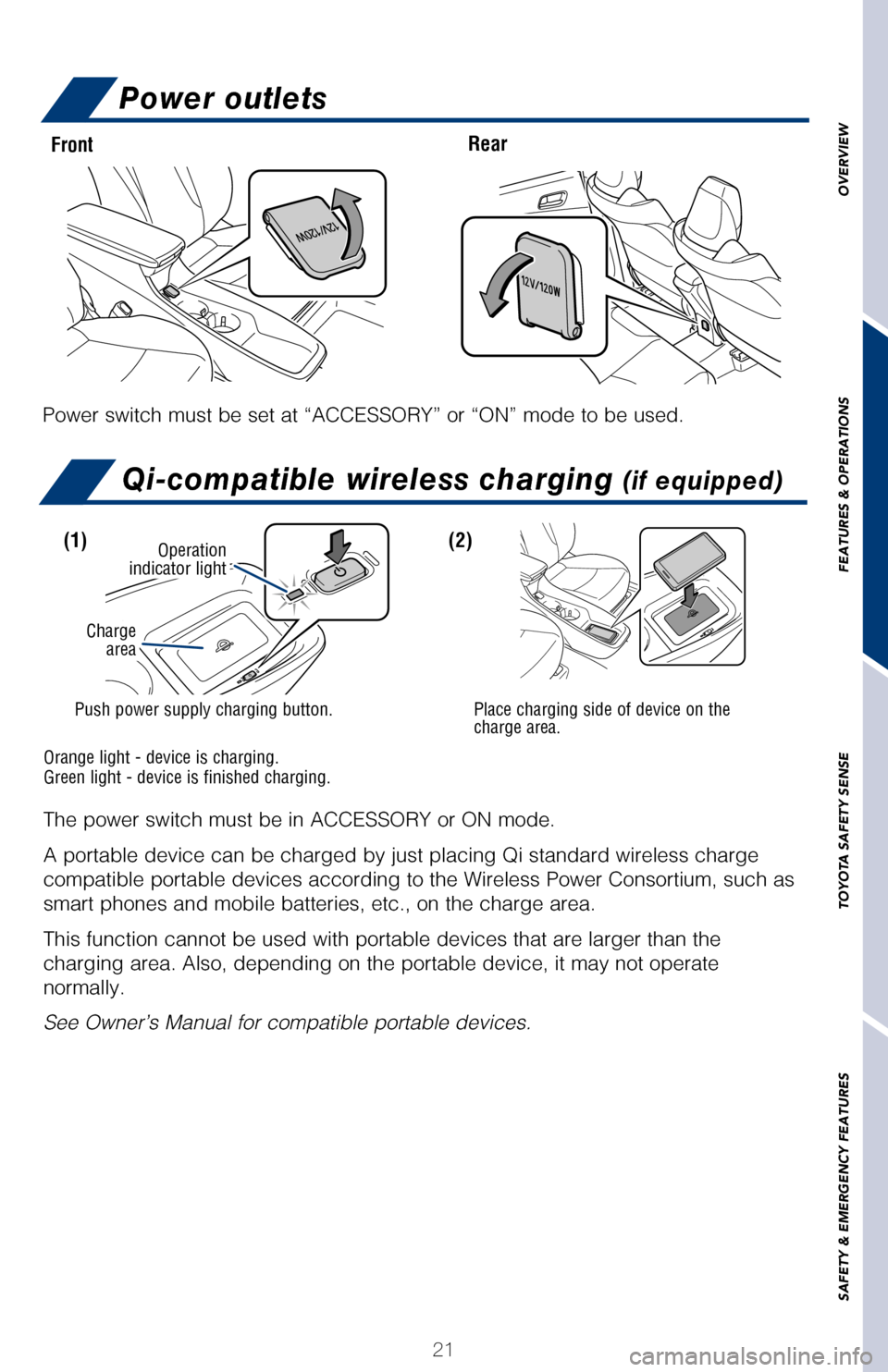
OVERVIEW
FEATURES & OPERATIONS
TOYOTA SAFETY SENSE
SAFETY & EMERGENCY FEATURES
TYPE 2 - ENTUNE™ PREMIUM (JBL®) AUDIO WITH INTEGRATED
NAVIGATION AND APP SUITE
21
Qi-compatible wireless charging (if equipped)
The power switch must be in ACCESSORY or ON mode.
A portable device can be charged by just placing Qi standard wireless ch\
arge
compatible portable devices according to the Wireless Power Consortium, \
such as
smart phones and mobile batteries, etc., on the charge area.
This function cannot be used with portable devices that are larger than \
the
charging area. Also, depending on the portable device, it may not operat\
e
normally.
See Owner’s Manual for compatible portable devices.
HOME Button
Access to Home
screen.
HOME SCREEN - the home screen offers a two panel and a three panel layou\
t. Information and
layout will vary depending on selected set up.
Power outlets
Front Rear
Power switch must be set at “ACCESSORY” or “ON” mode to be u\
sed.
Seek station/
CD track select
Turn to tune radio
stations manually
or select tracks or
files
Touch to pause or
resume playing
Refer to the “2017 Entune™ Audio Quick Reference Guide” or the \
“Navigation
System Owner’s Manual” for more details.
NOTE: Concentrating on the road should always be your first priority whi\
le driving. Do
not use the Entune system if it will distract you.
By inserting a USB or an auxilary cable plug into the USB/AUX port, you \
can listen
to music from a portable audio device through the vehicle’s speaker system while in
USB/AUX mode.
Refer to the “Navigation System Owner’s Manual” for instruction\
s and more
information.
Push power supply charging button.
(1)(2)
Place charging side of device on the
charge area.
Operation
indicator light
Charge area
Orange light - device is charging.
Green light - device is finished charging.
Button
Access telephone
option screen.
2017_Prius_D6_1.indd 219/25/16 2:38 AM
Page 24 of 56

22
Clock
Cruise control
If the sensors detect an obstacle, the buzzer and MID display informs the \
driver of
the approximate position and distance of the obstacle by illuminating conti\
nuously
(far) or blinking (near).
Note: Use
in the Multi-Information Display (MID) to change settings. The
system will continue in the last state it was in (ON or OFF) when the engine\
is
started again.
Refer to section S-APGS (Simple Advanced Parking Guidance System) in the
Owner’s Manual for more details.
1 The set speed may also be cancelled by depressing the brake pedal.2 The set speed may be resumed once vehicle speed exceeds 25 mph.
To adjust the time, use meter control switches to go to the screen on the MID.
Then, select the
option to access the clock setting.
TURN SYSTEM ON/OFF
FUNCTIONS
FEATURES & OPERATIONS
System ON/OFF
Increase speed
Multi-Information Display (MID)
Clock display
Meter control switches
Decrease speed
Cancel1
Resume2
Set
2017_Prius_D6_1.indd 229/25/16 2:38 AM
Page 25 of 56

OVERVIEW
FEATURES & OPERATIONS
TOYOTA SAFETY SENSE
SAFETY & EMERGENCY FEATURES
23
Intelligent Parking Assist (IPA) (if equipped)
Cruise control
If the sensors detect an obstacle, the buzzer and MID display informs th\
e driver of
the approximate position and distance of the obstacle by illuminating co\
ntinuously
(far) or blinking (near).
Note: Use
in the Multi-Information Display (MID) to change settings. The
system will continue in the last state it was in (ON or OFF) when the \
engine is
started again.
Refer to section S-APGS (Simple Advanced Parking Guidance System) in t\
he
Owner’s Manual for more details.
Front
center sensor
Rear
center sensor
1 The set speed may also be cancelled by depressing the brake pedal.2 The set speed may be resumed once vehicle speed exceeds 25 mph.
To adjust the time, use meter control switches to go to the
screen on the MID.
Then, select the
option to access the clock setting.
Corner sensors
(front and rear)
Corner sensors
(front and rear)
Side sensors
(front and rear)
Side sensors
(front and rear)
Corner sensors
(front and rear)
Corner sensors
(front and rear)
Increase speed
2017_Prius_D6_1.indd 239/25/16 2:38 AM
Page 26 of 56
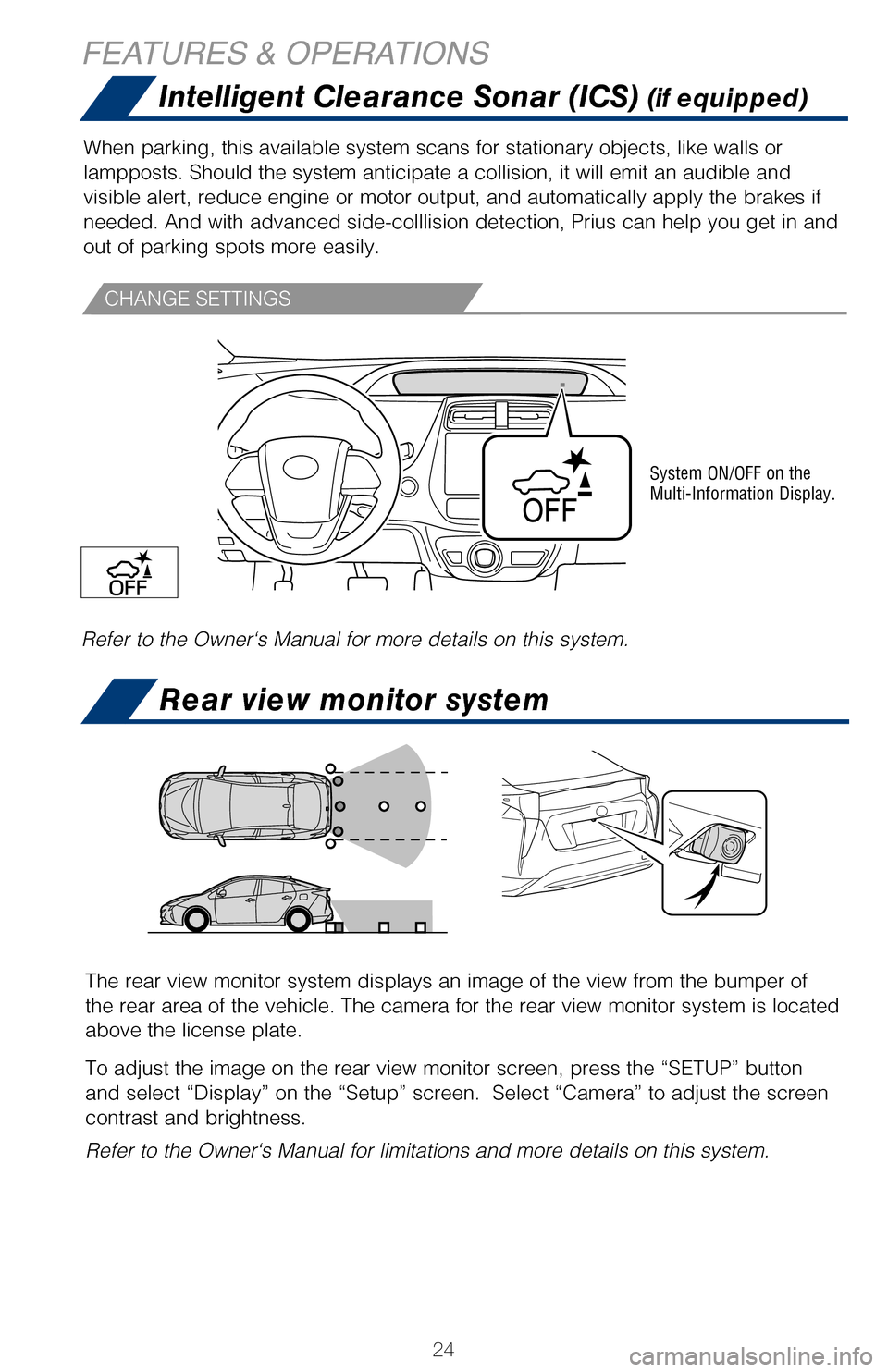
24
Intelligent Clearance Sonar (ICS) (if equipped)
When parking, this available system scans for stationary objects, like w\
alls or
lampposts. Should the system anticipate a collision, it will emit an aud\
ible and
visible alert, reduce engine or motor output, and automatically apply th\
e brakes if
needed. And with advanced side-colllision detection, Prius can help you \
get in and
out of parking spots more easily.
Refer to the Owner‘s Manual for more details on this system.
System ON/OFF on the
Multi-Information Display.
The Blind Spot Monitor is a system that has two functions:
• The Blind Spot Monitor function (assists the driver in making the decision when changing lanes)
• The Rear Cross Traffic Alert function (assists the driver when backing up)
The system is designed to use radar sensors to detect vehicles traveling in the
Prius’ blind spot and advises the driver of the vehicles’ presence\
via the outside
rear view mirror indicators.
Note: Use
in the Multi-Information Display (MID) to change settings. The
system will continue in the last state it was in (ON or OFF) when the \
engine is
started again.
Refer to the Owner‘s Manual for limitations and more details on this \
system before
attempting to use it.
Garage door openers manufactured under license from HomeLink
®* can be
programmed to operate garage doors, estate gates, security lighting, etc\
.
Refer to “Garage door opener,” Section 3-5 in the Owner’s Manua\
l for more
details.
For programming assistance, contact HomeLink
® at 1-800-355-3515, or visit http://
www.homelink.com.
* HomeLink® is a registered trademark of Johnson Controls, Inc.
CHANGE SETTINGS
FEATURES & OPERATIONS
Rear view monitor system
The rear view monitor system displays an image of the view from the bumper of
the rear area of the vehicle. The camera for the rear view monitor system is located
above the license plate.
To adjust the image on the rear view monitor screen, press the “SETUP” button
and select “Display” on the “Setup” screen. Select “Camera” to adjust the screen
contrast and brightness.
Refer to the Owner‘s Manual for limitations and more details on this \
system.
2017_Prius_D6_1.indd 249/25/16 2:38 AM
Page 27 of 56
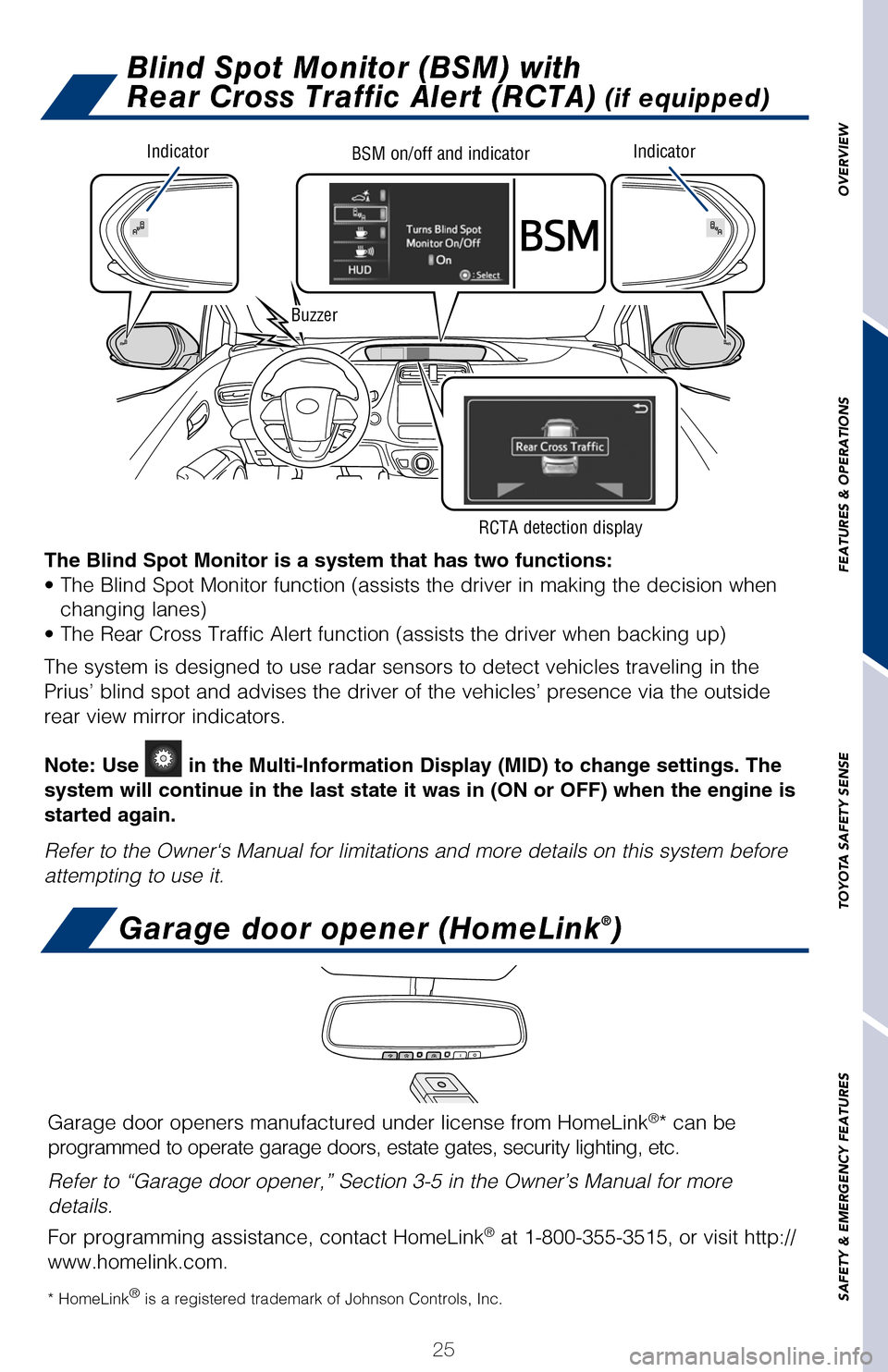
OVERVIEW
FEATURES & OPERATIONS
TOYOTA SAFETY SENSE
SAFETY & EMERGENCY FEATURES
25
Intelligent Clearance Sonar (ICS) (if equipped)
Blind Spot Monitor (BSM) with
Rear Cross Traffic Alert (RCTA)
(if equipped)
Garage door opener (HomeLink®)
When parking, this available system scans for stationary objects, like w\
alls or
lampposts. Should the system anticipate a collision, it will emit an aud\
ible and
visible alert, reduce engine or motor output, and automatically apply th\
e brakes if
needed. And with advanced side-colllision detection, Prius can help you \
get in and
out of parking spots more easily.
Refer to the Owner‘s Manual for more details on this system.
System ON/OFF on the
Multi-Information Display.
The Blind Spot Monitor is a system that has two functions:
• The Blind Spot Monitor function (assists the driver in making the decision when changing lanes)
• The Rear Cross Traffic Alert function (assists the driver when backing up)
The system is designed to use radar sensors to detect vehicles traveling in the
Prius’ blind spot and advises the driver of the vehicles’ presence\
via the outside
rear view mirror indicators.
Note: Use
in the Multi-Information Display (MID) to change settings. The
system will continue in the last state it was in (ON or OFF) when the \
engine is
started again.
Refer to the Owner‘s Manual for limitations and more details on this \
system before
attempting to use it.
Garage door openers manufactured under license from HomeLink®* can be
programmed to operate garage doors, estate gates, security lighting, etc\
.
Refer to “Garage door opener,” Section 3-5 in the Owner’s Manua\
l for more
details.
For programming assistance, contact HomeLink
® at 1-800-355-3515, or visit http://
www.homelink.com.
* HomeLink® is a registered trademark of Johnson Controls, Inc.
Rear view monitor system
The rear view monitor system displays an image of the view from the bumper of
the rear area of the vehicle. The camera for the rear view monitor system is located
above the license plate.
To adjust the image on the rear view monitor screen, press the “SETUP” button
and select “Display” on the “Setup” screen. Select “Camera” to adjust the screen
contrast and brightness.
Refer to the Owner‘s Manual for limitations and more details on this \
system.
IndicatorIndicatorBSM on/off and indicator
Buzzer
RCTA detection display
2017_Prius_D6_1.indd 259/25/16 2:38 AM
Page 28 of 56
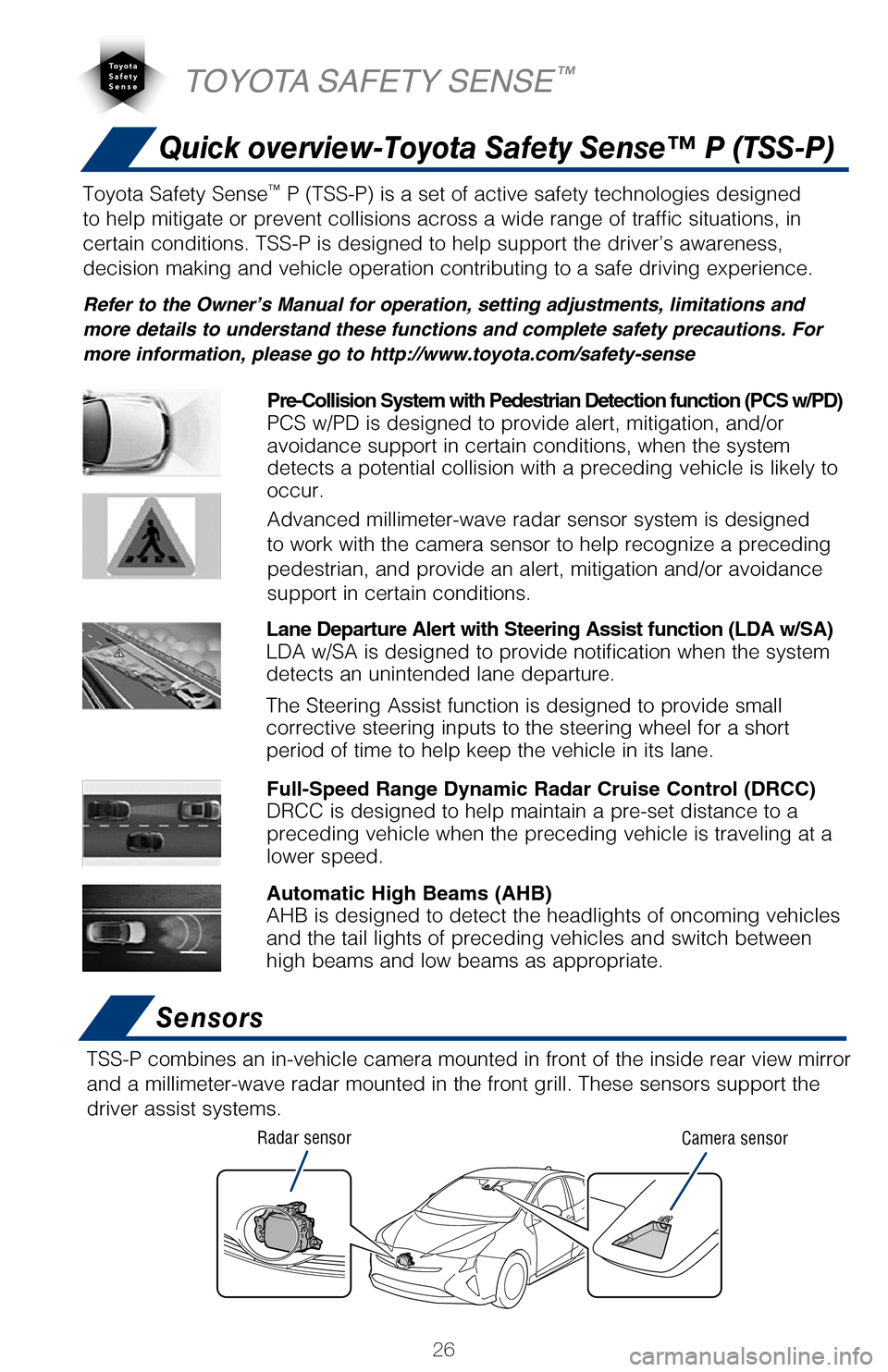
26
Quick overview-Toyota Safety Sense™ P (TSS-P)
Sensors
TSS-P combines an in-vehicle camera mounted in front of the inside rear \
view mirror
and a millimeter-wave radar mounted in the front grill. These sensors su\
pport the
driver assist systems.
Camera sensor
Radar sensor
TOYOTA SAFETY SENSE™
The Pre-Collision System uses a radar sensor and camera sensor to help d\
etect
vehicles and pedestrians in front of your vehicle.
As there is a limit to the degree of recognition accuracy and control pe\
rformance
that this system can provide, do not overly rely on this system. This sy\
stem will not
prevent collisions or lessen collision damage or injury in every situati\
on. Do not use
PCS instead of normal braking operations under any circumstances. Do not\
attempt
to test the operation of the pre-collision system yourself, as the syste\
m may not
operate or engage, possibly leading to an accident. In some situations, \
such as
when driving in inclement weather such as heavy rain, fog, snow or a san\
dstorm or
while driving on a curve and for a few seconds after driving on a curve,\
a vehicle
may not be detected by the radar and camera sensors, preventing the syst\
em from
operating or engaging properly.
Refer to a Toyota Owner’s Manual for a list of additional situations \
in which the
system may not operate properly.
Refer to a Toyota Owner’s Manual for additional information on PCS w/\
PD operation,
settings adjustments, limitations, and precautions before attempting to \
use it. Pre-Collision Warning
When the system determines that the possibility of a frontal collision i\
s high, a
buzzer will sound and a warning message will be displayed on the Multi-I\
nformation
Display (MID) to urge the driver to take evasive action.
Pre-Collision Brake Assist
If the driver notices the hazard and brakes, the system may provide addi\
tional
braking force using Brake Assist. This system may prime the brakes and m\
ay apply
greater braking force in relation to how strongly the brake pedal is dep\
ressed.
Pre-Collision Braking
If the driver does not brake in a set time and the system determines tha\
t the
possibility of a frontal collision with a preceding vehicle is extremely\
high, the
system may automatically apply the brakes, reducing speed in order to he\
lp the
driver reduce the impact and in certain cases avoid the collision.
Toyota Safety Sense™ P (TSS-P) is a set of active safety technologies designed
to help mitigate or prevent collisions across a wide range of traffic situations, in
certain conditions. TSS-P is designed to help support the driver’s aw\
areness,
decision making and vehicle operation contributing to a safe driving exp\
erience.
Refer to the Owner’s Manual for operation, setting adjustments, limitations and
more details to understand these functions and complete safety precautions. For
more information, please go to http://www.toyota.com/safety-sense
Lane Departure Alert with Steering Assist function (LDA w/SA)
LDA w/SA is designed to provide notification when the system
detects an unintended lane departure.
The Steering Assist function is designed to provide small
corrective steering inputs to the steering wheel for a short
period of time to help keep the vehicle in its lane.
Automatic High Beams (AHB)
AHB is designed to detect the headlights of oncoming vehicles
and the tail lights of preceding vehicles and switch between
high beams and low beams as appropriate.
Pre-Collision System with Pedestrian Detection function (PCS w/PD)
PCS w/PD is designed to provide alert, mitigation, and/or
avoidance support in certain conditions, when the system
detects a potential collision with a preceding vehicle is likely to
occur.
Advanced millimeter-wave radar sensor system is designed
to work with the camera sensor to help recognize a preceding
pedestrian, and provide an alert, mitigation and/or avoidance
support in certain conditions.
Full-Speed Range Dynamic Radar Cruise Control (DRCC)
DRCC is designed to help maintain a pre-set distance to a
preceding vehicle when the preceding vehicle is traveling at a
lower speed.
2017_Prius_D6_1.indd 269/25/16 2:38 AM
Page 29 of 56
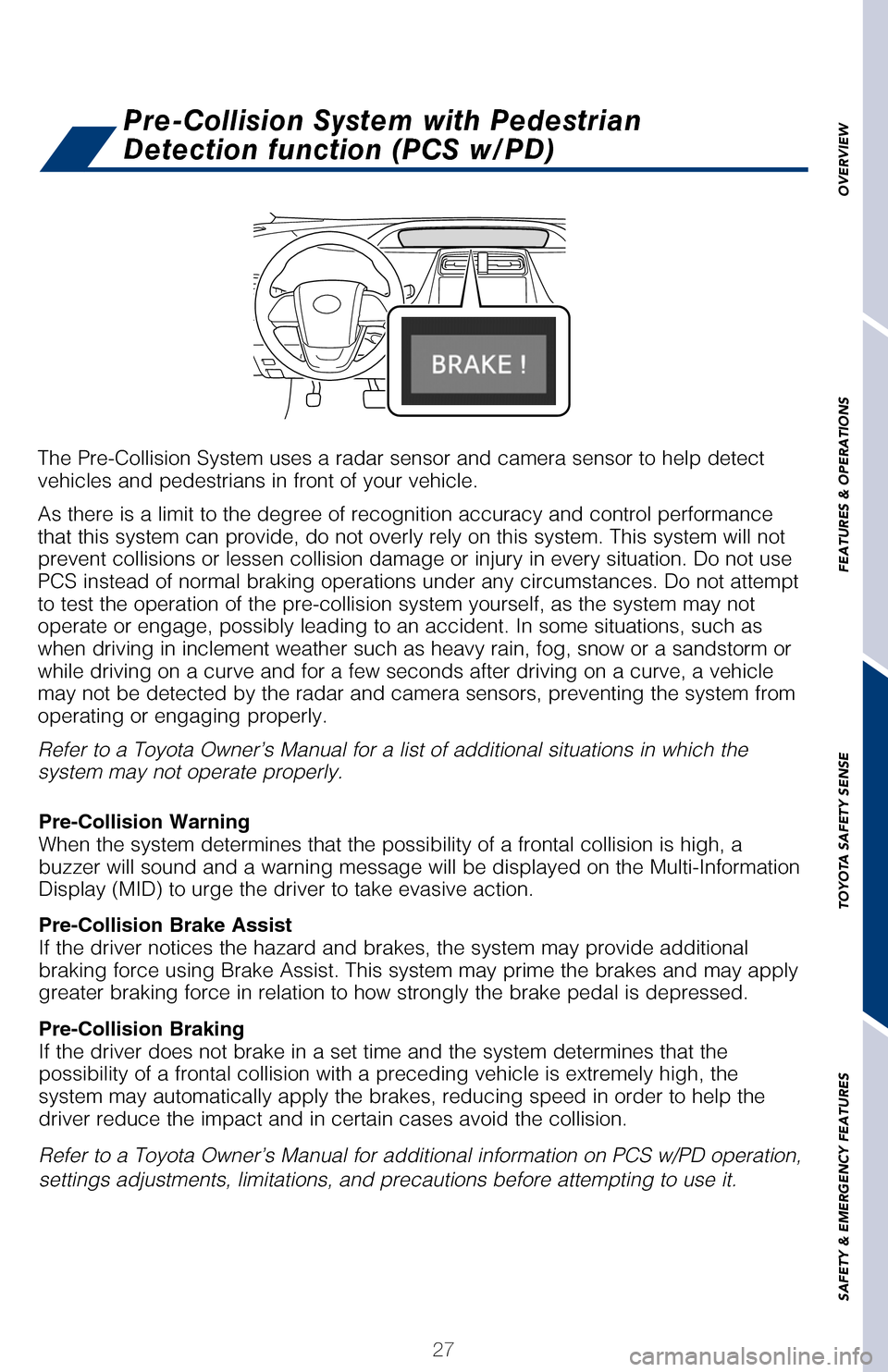
OVERVIEW
FEATURES & OPERATIONS
TOYOTA SAFETY SENSE
SAFETY & EMERGENCY FEATURES
27
Quick overview-Toyota Safety Sense™ P (TSS-P)
Sensors
TSS-P combines an in-vehicle camera mounted in front of the inside rear \
view mirror
and a millimeter-wave radar mounted in the front grill. These sensors su\
pport the
driver assist systems.
Camera sensor
The Pre-Collision System uses a radar sensor and camera sensor to help d\
etect
vehicles and pedestrians in front of your vehicle.
As there is a limit to the degree of recognition accuracy and control pe\
rformance
that this system can provide, do not overly rely on this system. This sy\
stem will not
prevent collisions or lessen collision damage or injury in every situati\
on. Do not use
PCS instead of normal braking operations under any circumstances. Do not\
attempt
to test the operation of the pre-collision system yourself, as the syste\
m may not
operate or engage, possibly leading to an accident. In some situations, \
such as
when driving in inclement weather such as heavy rain, fog, snow or a san\
dstorm or
while driving on a curve and for a few seconds after driving on a curve,\
a vehicle
may not be detected by the radar and camera sensors, preventing the syst\
em from
operating or engaging properly.
Refer to a Toyota Owner’s Manual for a list of additional situations \
in which the
system may not operate properly.
Refer to a Toyota Owner’s Manual for additional information on PCS w/\
PD operation,
settings adjustments, limitations, and precautions before attempting to \
use it. Pre-Collision Warning
When the system determines that the possibility of a frontal collision i\
s high, a
buzzer will sound and a warning message will be displayed on the Multi-I\
nformation
Display (MID) to urge the driver to take evasive action.
Pre-Collision Brake Assist
If the driver notices the hazard and brakes, the system may provide addi\
tional
braking force using Brake Assist. This system may prime the brakes and m\
ay apply
greater braking force in relation to how strongly the brake pedal is dep\
ressed.
Pre-Collision Braking
If the driver does not brake in a set time and the system determines tha\
t the
possibility of a frontal collision with a preceding vehicle is extremely\
high, the
system may automatically apply the brakes, reducing speed in order to he\
lp the
driver reduce the impact and in certain cases avoid the collision.
Pre-Collision System with Pedestrian
Detection function (PCS w/PD)
Toyota Safety Sense™ P (TSS-P) is a set of active safety technologies designed
to help mitigate or prevent collisions across a wide range of traffic situations, in
certain conditions. TSS-P is designed to help support the driver’s aw\
areness,
decision making and vehicle operation contributing to a safe driving exp\
erience.
Refer to the Owner’s Manual for operation, setting adjustments, limitations and
more details to understand these functions and complete safety precautions. For
more information, please go to http://www.toyota.com/safety-sense
Lane Departure Alert with Steering Assist function (LDA w/SA)
LDA w/SA is designed to provide notification when the system
detects an unintended lane departure.
The Steering Assist function is designed to provide small
corrective steering inputs to the steering wheel for a short
period of time to help keep the vehicle in its lane.
Automatic High Beams (AHB)
AHB is designed to detect the headlights of oncoming vehicles
and the tail lights of preceding vehicles and switch between
high beams and low beams as appropriate. Pre-Collision System with Pedestrian Detection function (PCS w/PD)
PCS w/PD is designed to provide alert, mitigation, and/or
avoidance support in certain conditions, when the system
detects a potential collision with a preceding vehicle is likely to
occur.
Advanced millimeter-wave radar sensor system is designed
to work with the camera sensor to help recognize a preceding
pedestrian, and provide an alert, mitigation and/or avoidance
support in certain conditions.
Full-Speed Range Dynamic Radar Cruise Control (DRCC)
DRCC is designed to help maintain a pre-set distance to a
preceding vehicle when the preceding vehicle is traveling at a
lower speed.
2017_Prius_D6_1.indd 279/25/16 2:38 AM
Page 30 of 56
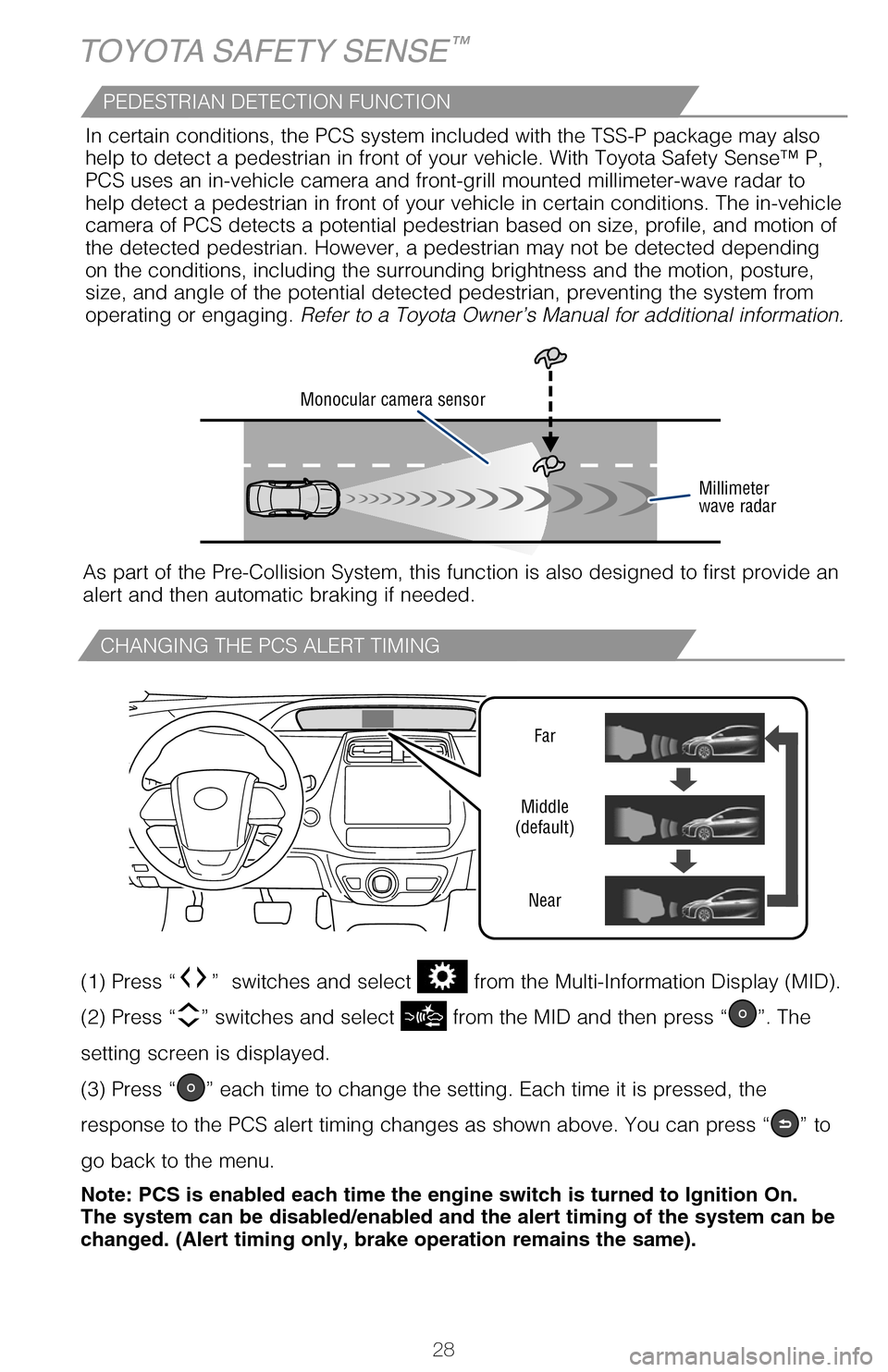
28
CHANGING THE PCS ALERT TIMING
DISABLING THE PRE-COLLISION SYSTEM (PCS)
TOYOTA SAFETY SENSE™
Far
Middle
(default)
Near
LDA in TSS-P uses an in-vehicle camera designed to detect visible white \
and yellow
lane markers in front of the vehicle and the vehicle’s position on th\
e road. If the
system determines that the vehicle is starting to unintentionally deviat\
e from its lane,
the system alerts the driver with an audio and visual alert. When the al\
erts occur, the
driver must check the surrounding road situation and carefully operate t\
he steering
wheel to move the vehicle back to the center part of their lane.
LDA is designed to function at speeds of approximately 32 MPH or higher \
on
relatively straight roadways.
In addition to the alert function, LDA w/SA also features a steering ass\
ist
function. When enabled, if the system determines that the vehicle is on \
a path to
unintentionally depart from its lane, the system may provide small corrective steering
inputs to the steering wheel for a short period of time to help keep the\
vehicle in its
lane.
(1) Press “” switches and select from the Multi-Information Display (MID).
(2) Press “
” switches and select from the MID and then press “”. The
setting screen is displayed.
(3) Press “
” each time to change the setting. Each time it is pressed, the
response to the PCS alert timing changes as shown above. You can press “\
” to
go back to the menu.
Note: PCS is enabled each time the engine switch is turned to Ignition O\
n.
The system can be disabled/enabled and the alert timing of the system ca\
n be
changed. (Alert timing only, brake operation remains the same).
(1) Press “ ” switches and select from the Multi-Information Display (MID).
(2) Press “ ” switches and select the
setting function from the MID and then
press “
”. The setting screen is displayed.
(3) Press “
” each time to change the setting. You can press “” to go back to
the menu.
Monocular camera sensor
Millimeter
wave radar
As part of the Pre-Collision System, this function is also designed to first provide an
alert and then automatic braking if needed.In certain conditions, the PCS system included with the TSS-P package ma\
y also
help to detect a pedestrian in front of your vehicle. With Toyota Safety\
Sense™ P,
PCS uses an in-vehicle camera and front-grill mounted millimeter-wave ra\
dar to
help detect a pedestrian in front of your vehicle in certain conditions.\
The in-vehicle
camera of PCS detects a potential pedestrian based on size, profile, and motion of
the detected pedestrian. However, a pedestrian may not be detected depen\
ding
on the conditions, including the surrounding brightness and the motion, \
posture,
size, and angle of the potential detected pedestrian, preventing the sys\
tem from
operating or engaging. Refer to a Toyota Owner’s Manual for additional information.
PEDESTRIAN DETECTION FUNCTION
2017_Prius_D6_1.indd 289/25/16 2:38 AM